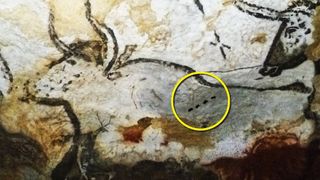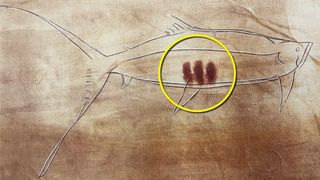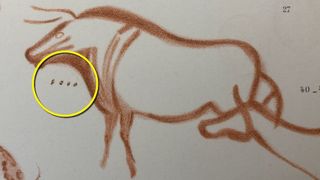At minimum 20,000 several years ago, individuals dwelling in Europe made putting cave paintings of animals that they paired with curious indications: lines, dots and Y-shaped symbols. These marks, which are nicely known to scientists, may relate to the seasonal behavior of prey animals, making the indications the 1st regarded crafting in the history of humankind, a new study claims.
Whilst Paleolithic cave art is far better recognized for its graceful horses and ghostly handprints, there are thousands of nonfigurative or summary marks that scientists have begun researching only in the earlier handful of many years. In a study posted Jan. 5 in the Cambridge Archaeology Journal (opens in new tab), a staff of students suggests that these seemingly summary dots and strains, when positioned around animal imagery, really stand for a refined writing technique that points out early humans’ comprehending of the mating and birthing seasons of significant nearby species.
Other researchers, on the other hand, are not convinced by the study’s interpretations of these human-built marks.
Melanie Chang (opens in new tab), a paleoanthropologist at Portland Condition University who was not concerned in the study, instructed Stay Science in an electronic mail that she agrees with the researchers’ evaluation that “Upper Palaeolithic individuals experienced the cognitive capacity to compose and to maintain records of time.” However, she cautioned that the researchers’ “hypotheses are not very well-supported by their benefits, and they also do not handle different interpretations of the marks they analyzed.”
Similar: Back to the Stone Age: 17 important milestones in Paleolithic daily life
What do the painted marks mean?
Early individuals in Europe were being hunter-gatherers who ate a great deal of meat from species this kind of as horses, deer and bison. When these animals came collectively seasonally in herds, they would have been vulnerable to slaughter by people. “It follows that awareness of the timing of migrations, mating and birthing would be a central problem to Higher Paleolithic behaviour,” analyze very first author Bennett Bacon (opens in new tab), an impartial researcher and furniture conservator based in London, and colleagues wrote in their examine.
Seeking at the full range of marks — both dots or lines — found in sequences across hundreds of caves, the researchers found out that none of the collection contained extra than 13 marks, regular with the 13 lunar months in just about every yr. “We hypothesize that sequences are conveying facts about their linked animal taxa in units of months,” they wrote, noting that spring, “with its noticeable signals of the conclusion of winter and corresponding faunal migrations to breeding grounds, would have delivered an apparent, if regionally differing, point of origin for the lunar calendar.”
The researchers’ statistical assessment of additional than 800 sequences of marks related with animals supports their notion — they discovered potent correlations amongst the quantity of marks and the lunar months in which the certain animal is regarded to mate.
Having their hypothesis a move even further, Bacon and colleagues concentrated on a Y-shaped indicator that they believe refers to a unique celebration in an animal’s lifetime cycle. Identical statistical examination supports their conclusion that the placement of the Y-shaped signal within just a series of marks indicators an animal species’ birthing period.
“The ability to assign abstract signals to phenomena in the earth,” they wote, “to document past functions and forecast foreseeable future events, was a profound intellectual accomplishment.”
Crafting or proto-writing?
But is this the earliest known creating? Bacon and colleagues demur, suggesting that “it is best explained as a proto-writing technique, an middleman step between a easier notation/convention and comprehensive-blown composing.”
April Nowell (opens in new tab), a Paleolithic archaeologist at the College of Victoria in Canada who was not included in this examine, instructed Live Science by electronic mail that “any research that explores non-figurative signals in extra depth is welcome, but I imagine there are a variety of assumptions currently being built in this article that have nevertheless to be verified.” Nowell questioned the Y sign, in specific. “The greater part of animals regarded in this study are quadrupeds, and individuals generally squat offering delivery,” she explained. “If this sign is supposed to be iconic of the start procedure, it is not noticeable to me.”
Related: A single of the oldest penned sentences on report blasts hair and beard lice
Chang, the paleoanthropologist who is also an equestrian and horse proprietor, posed two alternative explanations for the Y signal. In some instances, it could characterize the edge of the brachiocephalic muscle, a notable landmark on a horse’s neck. “In other scenarios,” she said, “it is possible that what they recorded as Y’s depict what modern-day horsepeople refer to as ‘primitive markings’ these as leg bars that are linked with wild-sort horse colours, or they may well stand for hair designs, or other anatomical characteristics.”
Research co-writer Robert Kentridge (opens in new tab), a professor in the Department of Psychology at Durham College in the U.K., instructed Are living Science in an email that 1 of the strengths of their analyze is that they “have formally analyzed Ben [Bacon’s] hypotheses about the that means of the Y-sign’s placement in sequences of marks and the lengths of sequences of dots and traces and demonstrated that these do convey indicating, in fact which means that would be important in the life of Palaeolithic hunters.”
In summarizing their conclusions, Bacon and colleagues wrote that they have “proposed the existence of a notational system linked with an unambiguous animal matter relating to biologically sizeable situations” and that this permits them “for the 1st time to have an understanding of a Palaeolithic notational method in its entirety.”
A 10 years ago, however, Nowell and then-graduate scholar Genevieve von Petzinger (opens in new tab) co-made a database of dozens of signs and repeating motifs from more than 200 caves in southern France and Spain. Von Petzinger’s thesis (opens in new tab) in depth patterns of cave wall symbols across time and area in order to superior fully grasp what these signs meant for ice age people. “There are at minimum 32 distinctive recurring indicators,” Nowell spelled out. “The authors have picked to research three of them in a extremely precise context.”
But the authors defended their conclusion to target on the trio.
“It seemed practical to emphasis first on the most widespread markings involved with figurative images,” research co-author Paul Pettitt (opens in new tab), a professor of archaeology at Durham College, explained to Live Science in an e-mail. “Simple dots and traces are by considerably the most typical. Of the more elaborate symptoms, the Y indicator is the most popular.”
The researchers approach to develop on their operate. “We are analyzing other signs,” Bacon informed Stay Science in an e mail. “Somewhat than seeking for the that means of particular person indications, what we are seeking for is the linguistic and cognitive bases that underpin the ‘writing’ procedure.”
Nowell agreed with the analyze authors that the symbols have been likely not randomly chosen and that it is probable the lines and dots stand for quantities. Even if the authors are suitable, she mentioned, that leaves 90{af0afab2a7197b4b77fcd3bf971aba285b2cb7aa14e17a071e3a1bf5ccadd6db} of the symptoms with out any regarded that means.
“There is nevertheless a good deal about graphic communication in the Paleolithic that we do not recognize,” Nowell said.





